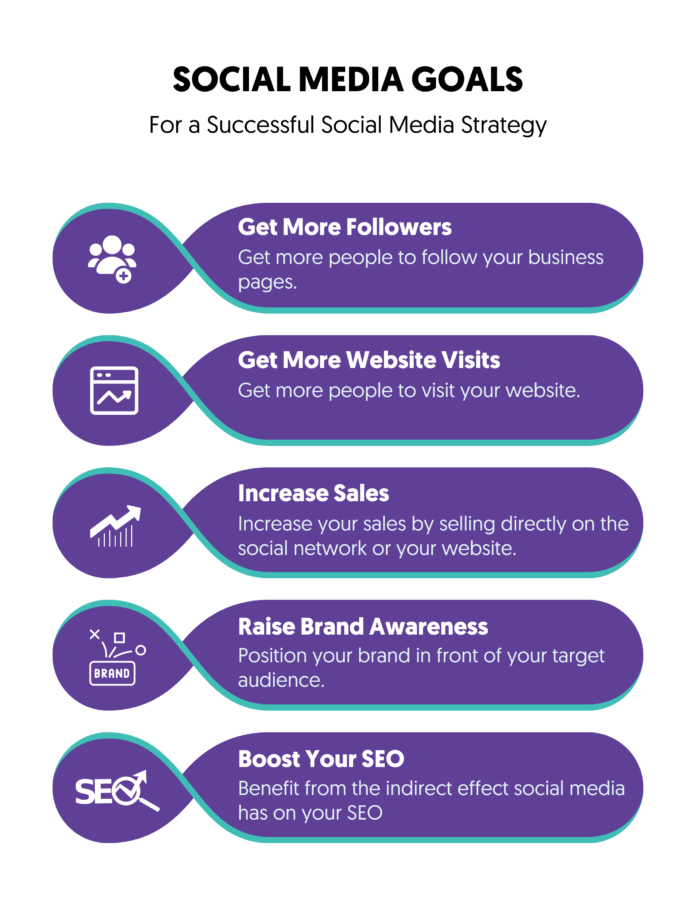In today’s fast-paced digital world, social media is no longer just a platform for sharing personal updates; it has evolved into a powerful tool for businesses. With billions of active users globally, platforms like Facebook, Instagram, Twitter, and LinkedIn offer unparalleled opportunities for brand engagement, customer interaction, and sales growth. However, to fully leverage these platforms, you need a well-structured social media marketing plan. This guide provides you with a step-by-step approach to creating a powerful social media marketing strategy that effectively engages your audience and drives meaningful results.
Step 1: Define Your Goals
The first step in your social media marketing journey is to clearly define your objectives. Establishing specific goals helps focus your efforts and measure your success. Common social media goals include:
- Increasing Brand Awareness: Striving to make your brand more recognizable within your target market.
- Driving Website Traffic: Encouraging users to visit your website through engaging content.
- Generating Leads: Capturing contact information from potential customers interested in your products or services.
- Boosting Engagement: Increasing likes, shares, comments, and overall interactions on your posts.
- Increasing Sales: Directly promoting products or services to enhance conversions.
Ensure your goals are SMART—Specific, Measurable, Attainable, Relevant, and Time-bound. For example, rather than saying, “I want to grow my followers,” a SMART goal would be, “I aim to gain 500 new followers on Instagram within the next three months.”
Step 2: Understand Your Target Audience
To craft relevant and engaging content, you need a deep understanding of your target audience. Conduct market research to create detailed buyer personas representing your ideal customers. Consider aspects such as:
- Demographics: Age, gender, location, income level, and education.
- Interests and Hobbies: What do they enjoy doing? What other brands do they engage with?
- Pain Points: What challenges do they face that your products or services can address?
Understanding these factors enables you to tailor your messaging, making it more likely to resonate with your audience.
Step 3: Choose the Right Platforms
Selecting the right social media platforms is crucial. Not every platform will suit your brand or your audience. Here’s a brief overview of popular platforms:
- Facebook: Excellent for building community and engagement.
- Instagram: Perfect for visual storytelling, reaching younger demographics.
- LinkedIn: Ideal for B2B marketing and professional networking.
- Twitter: Effective for real-time engagement, sharing news, and trending topics.
Choose platforms that align with your goals and where your audience spends their time. Focusing on the right channels will maximize your marketing efforts.
Step 4: Create Engaging Content
Content is the heart of your social media marketing plan. Develop a content calendar outlining what you’ll post and when. Ensure your content is diverse and includes:
- Educational Posts: Share valuable tips, how-tos, and industry insights.
- Promotional Content: Highlight your products or services and any special offers.
- User-Generated Content: Encourage your audience to share their experiences with your brand.
- Visual Media: Utilize images, videos, and infographics to capture attention and drive engagement.
Compelling content is more likely to be shared and can significantly increase your reach.
Step 5: Establish a Posting Schedule
Consistency is vital in social media marketing. Create a posting schedule to maintain a regular presence across your chosen platforms. Tools like Hootsuite, Buffer, or Sprout Social can help you schedule posts in advance. Research the best times to post for each platform to maximize engagement and visibility.
Step 6: Engage with Your Audience
Social media is a two-way street. Engaging with your audience fosters a sense of community and builds loyalty. Respond to comments, answer questions, and encourage conversations. Use interactive content like polls and quizzes to boost engagement. The more you interact, the more likely your audience will remain loyal to your brand.
Step 7: Monitor and Analyze Performance
To improve your social media strategy, you must track its performance. Utilize analytics tools to monitor key performance indicators (KPIs), including:
- Engagement Rate: Measure likes, shares, comments, and overall interactions with your content.
- Reach and Impressions: Assess how many people see your posts and how often they appear.
- Follower Growth: Track the increase in your follower count over time.
- Conversion Rates: Measure the percentage of users who take desired actions, like clicking links or making purchases.
Regularly analyzing these metrics will help you identify what’s working and what needs adjustment.
Step 8: Adjust Your Strategy
Based on your performance analysis, be prepared to adapt your strategy. Social media trends can change rapidly, so flexibility is essential. If a particular type of content is performing well, consider producing more of it. Conversely, if certain posts are underperforming, be willing to pivot your approach to better meet your audience’s preferences.
Step 9: Collaborate with Influencers
Influencer marketing can significantly enhance your social media reach and credibility. Identify influencers in your industry who align with your brand values. Collaborate with them to promote your products or services, leveraging their audience to expand your reach. Influencer partnerships can provide authentic content and foster trust among potential customers.
Step 10: Stay Updated on Trends
The digital marketing landscape is continually evolving. Stay informed about the latest social media trends, algorithm changes, and best practices. Follow industry blogs, attend webinars, and engage with online communities. This ongoing education will help you refine your strategy and maintain a competitive edge.
Conclusion
Creating a powerful social media marketing plan requires careful planning, execution, and analysis. By following these steps, you can effectively engage your audience, enhance your brand visibility, and drive meaningful results. If you need expert guidance in crafting your social media strategy, consider partnering with a digital marketing company in Udaipur like Yug Technology. Their expertise can help you navigate the complexities of social media marketing and achieve your business goals, ensuring that your efforts translate into success.



